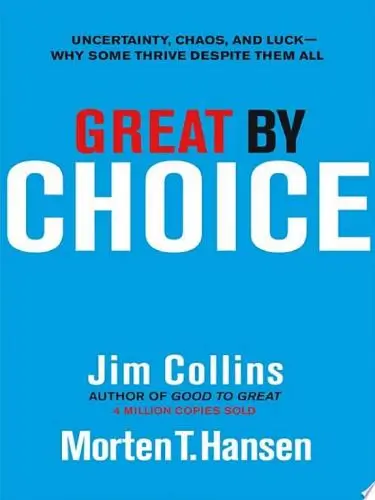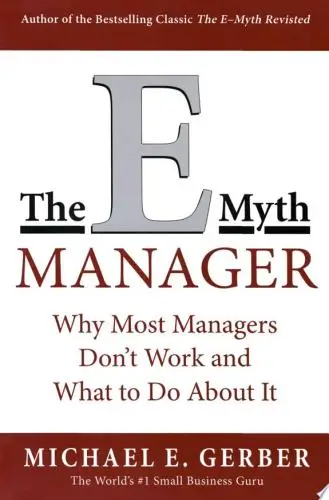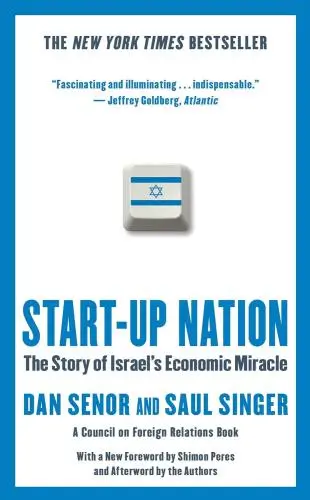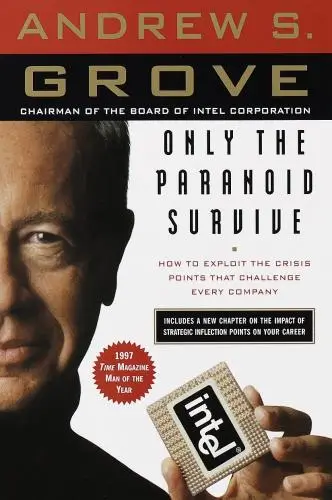Only the Paranoid Survive
How to Exploit the Crisis Points That Challenge Every Company
What's it about?
Only the Paranoid Survive by Andrew S. Grove offers a deep dive into the world of business strategy through the lens of Intel's legendary CEO. This enlightening read focuses on navigating strategic inflection points: moments when companies must adapt to major changes or face decline. Grove shares personal insights and actionable strategies to recognize these pivotal times, emphasizing that vigilance and flexibility are key to not just surviving, but thriving in a constantly evolving market landscape. A must-read for leaders and aspiring entrepreneurs alike.
About the Author
Andrew S. Grove was a Hungarian-born American businessman and author known for his influential work in the technology industry. His book "Only the Paranoid Survive" is a staple for business leaders navigating rapid change and disruption. Grove's writing style is straightforward and practical, offering valuable insights into leadership, strategy, and innovation. With a focus on adaptability and resilience, his work continues to inspire and guide entrepreneurs and executives in the ever-evolving business landscape.
10 Key Ideas of Only the Paranoid Survive
Embrace the Power of Strategic Inflection Points
Strategic inflection points are moments when the fundamentals of a business or industry undergo significant change, potentially altering its course forever.
Recognizing these points early is crucial as they offer both immense risk and opportunity.
The ability to identify, adapt to, and leverage these changes can set a company apart from its competitors.
This involves staying attuned to market signals, technological advancements, and shifts in consumer behavior, ensuring that the organization remains flexible and responsive to change.
Learn DeeperStay Informed: Regularly follow industry news, trends, and reports. This can be through trade publications, online forums, or networking groups related to your field. Being well-informed helps you spot changes early.
Encourage Open Communication: Foster an environment where team members feel comfortable sharing observations and insights about shifts in the market or customer behavior. These discussions can be invaluable in identifying potential inflection points.
Invest in Continuous Learning: Encourage yourself and your team to continuously upgrade skills and knowledge. This could involve attending workshops, webinars, or taking courses related to emerging technologies and market trends.
Conduct Regular Reviews: Set aside time periodically to review your business strategy in the context of current market conditions. Be prepared to pivot or make strategic adjustments based on new information or trends.
Engage with Your Customers: Regularly seek feedback from your customers to understand their changing needs and preferences. This direct line of communication can provide early warnings of shifting market dynamics.
- Example
A small bookstore noticing a shift towards digital reading platforms decides to diversify its offerings by including e-books and hosting virtual book clubs, leveraging the change to attract a broader audience.
- Example
A technology company observes an emerging trend in remote work and quickly adapts its product line to include more cloud-based collaboration tools, gaining a competitive edge in a rapidly changing market.
Cultivate a Culture of Paranoia and Preparedness
Adopting a mindset of constructive paranoia means always being vigilant about the threats that could undermine your business.
It's about constantly questioning the status quo and preparing for the worst-case scenarios.
This doesn't mean living in fear but rather maintaining a state of readiness to act swiftly and decisively against potential challenges.
Encouraging this culture throughout the organization ensures that everyone is alert, proactive, and engaged in safeguarding the company's future.
Learn DeeperRegularly Conduct Threat Assessments: Make it a habit to periodically evaluate your business environment for potential threats. This could be in the form of new competitors, changing market trends, or technological advancements that could disrupt your business model.
Foster Open Communication: Encourage team members at all levels to share their observations and concerns about potential threats to the business. A culture where employees feel comfortable voicing concerns means you can identify and address issues before they escalate.
Develop Contingency Plans: For each identified threat, work on creating a detailed action plan. This should outline the steps to take should the threat materialize, including who is responsible for what and the timeline for response.
Invest in Continuous Learning: Stay informed about your industry and beyond. Encourage your team to do the same by providing resources or time for learning. This keeps your business agile and better prepared to adapt to changes.
Practice Scenario Planning: Regularly engage in exercises that simulate different threat scenarios. This helps your team think through the practical implications of potential threats and refine your contingency plans.
- Example
A tech startup regularly reviews emerging technologies to assess which ones could potentially disrupt their current business model. They then brainstorm strategies to integrate or counteract these technologies.
- Example
A retail company encourages employees to report any unusual customer feedback or competitive activities they observe. This information is then discussed in monthly meetings to identify any potential threats and develop appropriate responses.
Foster Open Communication and Challenge Conformity
Creating an environment where employees feel comfortable voicing their opinions, doubts, and concerns is vital.
Open communication encourages the flow of ideas and fosters innovation, allowing the organization to detect and respond to inflection points more effectively.
Encouraging dissent and challenging conformity prevents groupthink, ensuring that decisions are well-considered and based on a diverse range of perspectives.
Learn DeeperEncourage Regular Feedback Sessions: Make it a routine part of your work environment to have open forums or one-on-one meetings where employees can share their thoughts and feedback without fear of retribution. This could be as simple as a weekly round-table discussion or an anonymous suggestion box.
Promote Diversity of Thought: Actively seek out and encourage different viewpoints during meetings or decision-making processes. This can be achieved by inviting team members from various departments or backgrounds to participate in discussions, ensuring a wide range of perspectives are considered.
Challenge the Status Quo: Regularly ask yourself and your team, 'Is there a better way to do this?' Encourage initiatives that question existing processes and propose innovative solutions. Reward those who bring new ideas to the table, even if the ideas are not always implemented.
Implement a 'No Penalty for Failure' Policy: Foster an environment where employees are not afraid to take risks or voice unconventional ideas. Make it clear that failure is seen as a step towards innovation and learning, rather than a reason for punishment.
- Example
A tech startup implements a monthly 'Innovation Day' where employees can work on any project they choose, regardless of their regular duties. The day concludes with a casual presentation session where everyone shares what they've worked on, encouraging creativity and cross-pollination of ideas.
- Example
A marketing firm holds 'Reverse Brainstorming' sessions where teams are asked to think of the worst possible ideas for a campaign. This humorous and unconventional approach often leads to laughter and breaks down barriers, but also surprisingly sparks innovative and effective strategies by flipping bad ideas into good ones.
Implement Rigorous Scenario Planning
Scenario planning involves envisioning various future states and developing plans to address each potential situation.
This strategic tool helps organizations anticipate changes, assess risks, and prepare for different outcomes.
By considering a wide range of possibilities, companies can develop flexible strategies that allow them to pivot quickly in response to unexpected events or market shifts.
Learn DeeperIdentify Key Factors: Start by identifying the key factors that could significantly impact your life or career. These might include industry trends, technological advancements, or personal milestones.
Develop Scenarios: For each key factor, imagine several different future scenarios. Think about both positive and negative outcomes and how they could unfold over time.
Create Action Plans: For each scenario, develop a specific action plan. What steps would you need to take to adapt or thrive in each situation? Consider skills you might need to acquire, networks you should build, or financial buffers you might need to create.
Review and Update Regularly: The future is always changing, so make it a habit to review your scenarios and action plans regularly. As new information comes to light, adjust your plans accordingly.
- Example
If you're in a tech-related field, one key factor might be the emergence of artificial intelligence. A positive scenario could involve AI creating new job opportunities in your field. An action plan for this scenario might include taking courses on AI and machine learning to stay ahead. A negative scenario could be AI making your current job obsolete. Your action plan might then focus on diversifying your skill set into areas less likely to be affected by automation.
- Example
For someone planning their financial future, a key factor could be the economic environment. A positive scenario might involve a booming economy that boosts your investments. Your action plan could include investing more aggressively. Conversely, a negative scenario might involve a severe recession. In this case, your action plan might focus on building a larger emergency fund and diversifying your investment portfolio to mitigate risk.
Prioritize Speed and Decisiveness in Decision-Making
In a rapidly changing business landscape, the speed and decisiveness of decision-making can be a critical competitive advantage.
Delayed responses to emerging threats or opportunities can result in missed chances or irreversible setbacks.
Organizations must streamline their decision-making processes, empowering leaders and teams to act quickly while ensuring that decisions are informed and strategic.
Learn DeeperSet Clear Decision Deadlines: Establish firm deadlines for making decisions. This creates a sense of urgency and prevents procrastination. For example, if you're deciding on a new software tool for your team, set a deadline for the decision and stick to it.
Empower Your Team: Delegate decision-making authority to those closest to the information. This reduces bottlenecks and speeds up the process. Ensure your team has the necessary training and confidence to make informed decisions.
Implement a 'Two-Meeting Rule' for Decision Making: The first meeting is to discuss the problem and gather input. The second meeting, ideally within a week, is to make the decision. This ensures decisions are made swiftly but with due consideration.
Use a Decision Matrix: When faced with multiple options, use a decision matrix to evaluate each against set criteria. This helps to quickly identify the best course of action based on objective factors.
Encourage a Culture of Action Over Perfection: Foster an environment where taking action is valued over waiting for the perfect solution. Encourage calculated risks and learn from the outcomes, adjusting strategies as necessary.
- Example
A tech startup is considering expanding its product line. Instead of lengthy deliberations, the CEO sets a one-month deadline for research, discussion, and final decision. The team is empowered to gather data and propose solutions, leading to a decisive and timely expansion strategy.
- Example
A marketing team is debating between two campaign strategies. They use the 'Two-Meeting Rule': the first to present and discuss options, the second to decide. They also employ a decision matrix to objectively assess each strategy against key performance indicators, leading to a clear, consensus-based choice.
Deeper knowledge. Personal growth. Unlocked.
Unlock this book's key ideas and 15M+ more. Learn with quick, impactful summaries.
Read Full SummarySign up and read for free!
Only the Paranoid Survive Summary: Common Questions
Experience Personalized Book Summaries, Today!
Discover a new way to gain knowledge, and save time.
Sign up for our 7-day trial now.
No Credit Card Needed

Similar Books

Emotional Intelligence at Work
Dalip Singh
Seeing the Big Picture
Kevin Cope
Leadership Is Concept Heavy
Dr. Enoch Antwi
Great by Choice
Jim Collins
The Leader′s Guide to Coaching in Schools
John Campbell
Preparing School Leaders for the 21st Century
Stephan Gerhard Huber
The E-Myth Manager
Michael E. Gerber
Leadership Is Language
L. David Marquet
Start-up Nation
Dan Senor
The Founder's Dilemmas
Noam WassermanTrending Summaries

Peak
Anders Ericsson
Never Split the Difference
Chris Voss
Smart Brevity
Jim VandeHei
The Psychology of Money
Morgan Housel
The First 90 Days
Michael D. Watkins
Atomic Habits
James Clear
Thinking, Fast and Slow
Daniel Kahneman
The Body Keeps the Score
Bessel van der Kolk M.D.
The Power of Regret
Daniel H. Pink
The Compound Effect
Darren HardyNew Books

Job Interviews For Dummies®
Joyce Lain Kennedy
Job Interviews In A Week
Alison Straw
Handbook of Career Development
Gideon Arulmani
The Art of Spending Money
Morgan Housel
$100M Offers
Alex Hormozi
A Candle for Kiri
Edna Mae Holm
Principles of Marketing, Global Edition
Gary Armstrong
Serpent Rising: The Kundalini Compendium
Neven Paar
Feeling Is the Secret
Neville Goddard

